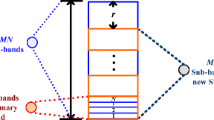Future wireless networks are envisioned to provide good quality multimedia services to mobile users anywhere at anytime. Traditional analysis of teletraffic in such networks assumes that call arrivals follow a Poisson process, as each cell is being modeled as an M/G/c/c queueing system. This does not reflect the real situation since handoff traffic arrivals are not generally Poissonian. In this paper, we propose to model each cell in future wireless networks as a G/G/c/c queueing system. As such a model has not been explicitly addressed in the literature, our main contribution is to propose a solution which enables to evaluate both traffic distribution and blocking probability within each cell of the service area. Result analysis reveals that coefficient of variation of call arrivals has more impact on the network performance than coefficient of variation of channel holding time.



Similar content being viewed by others
References
Fang Y., Chlamtac I., Lin Y.-B. (2000) Portable movement modeling for PCS networks. IEEE Transactions on Vehicular Technology 49(4):1356–1363
Orlik P. V., Rappaport S. S. (1998) A model for teletraffic performance and channel holding time characterization in wireless cellular communication with general session and dwell time distributions. IEEE Journal on Selected Areas in Communications 16(5):788–803
Lin Y.-B., Mohan S., Noerpel A. (1994) Queueing priority channel assignment strategies for PCS hand-off and initial access. IEEE Transactions on Vehicular Technology 43(3):704–712
Fang Y., Chlamtac I. (1999) Teletraffic analysis and mobility modelling of PCS networks. IEEE Transactions on Communications 47(7):1062–1072
C. Jedrzycki and V. C. M. Leung, Probability distributions of channel holding time in cellular telephone systems, IEEE Vehicular Technology Conference (VTC ’96), Atlanta, GA, May 1996, pp. 247–251
Fang Y., Chlamtac I., Lin Y. -B. (1997) Call performance for PCS network. IEEE Journal on Selected Areas in Communications 15(8):1568–1581
Kleinrock L. (1975) Queueing Systems: Vol I: Theory. John Wiley & Sons Inc., New York USA
Medhi J. (1991) Stochastic Models in Queueing Theory. Academic Press INC, San Diego
M. Rajaratnam and F. Takawira, Hand-off Traffic Modeling in Cellular Networks, IEEE Global Telecommunications Conference (Globecom ’97), 3–8 November 1997, Phoenix, AZ, pp. 131–137
R. J. Walstra, Nonexponential Networks of Queues: A Maximum Entropy Analysis, ACM SIGMETRICS Conference on Measurement and Modeling of Computer Systems, Austin, Texas, 26–29 August 1985, pp. 27–37
Hoorn M. H. V., Seelen L. P. (1986) Approximations for the GI/G/c queue. Journal of Applied Probability 23:484–494
Simonot F. (1998) A Comparison of the Stationary Distributions of GI/M/c/k and GI/M/c. Journal of Applied Probability 35:510–515
Ferdinand A. E. (1970) A statistical mechanical approach to systems analysis. IBM Journal of Research and Development 14(5):539–547
Shore J. E. (1982) Information theoretic approximations for M/G/1 and G/G/1 queueing systems. Acta Informatica 17:43–61
El-Affendi M. A., Kouvatsos D. D. (1983) A maximum entropy analysis of the M/G/1 and G/M/1 queueing systems at equilibrium. Acta Informatica 19:339–355
Kouvatsos D. D. (1986) Maximum entropy and the G/G/1/N queue. Acta Informatica 23:545–565
G. Miller and D. Horn, Maximum entropy approach to probability density estimation, Second International Conference on Knowledge-Based Intelligent Electronic Systems, 21–23 April 1998, Adelaide, Australia, pp. 225–230
R. Beaubrun, S. Pierre, and J. Conan, Blocking Probability Analysis in Future Wireless Networks, 2004 IEEE International Conference on Communications (ICC 2004), Paris, France, 20–24 June 2004, pp. 2323–2326
Kouvatsos D. D., Xenios N. P. (1989) MEM for arbitrary queueing networks with multiple general servers and repetitive-service blocking. Performance Evaluation 10:169–195
Kesavan H. K., Kapur J. N. (1989) The generalized maximum entropy principle. IEEE Transactions on Systems, Man, and Cybernetics 19:5
Author information
Authors and Affiliations
Corresponding author
Rights and permissions
About this article
Cite this article
Beaubrun, R., Pierre, S. & Conan, J. Analysis of Traffic Distribution and Blocking Probability in Future Wireless Networks. Int J Wireless Inf Networks 14, 47–53 (2007). https://doi.org/10.1007/s10776-006-0054-x
Published:
Issue Date:
DOI: https://doi.org/10.1007/s10776-006-0054-x




